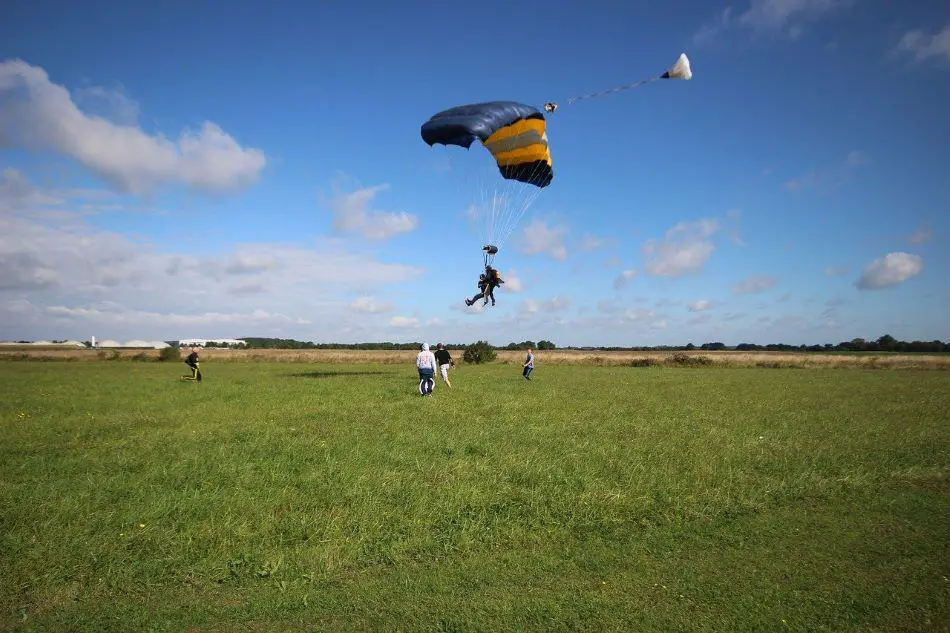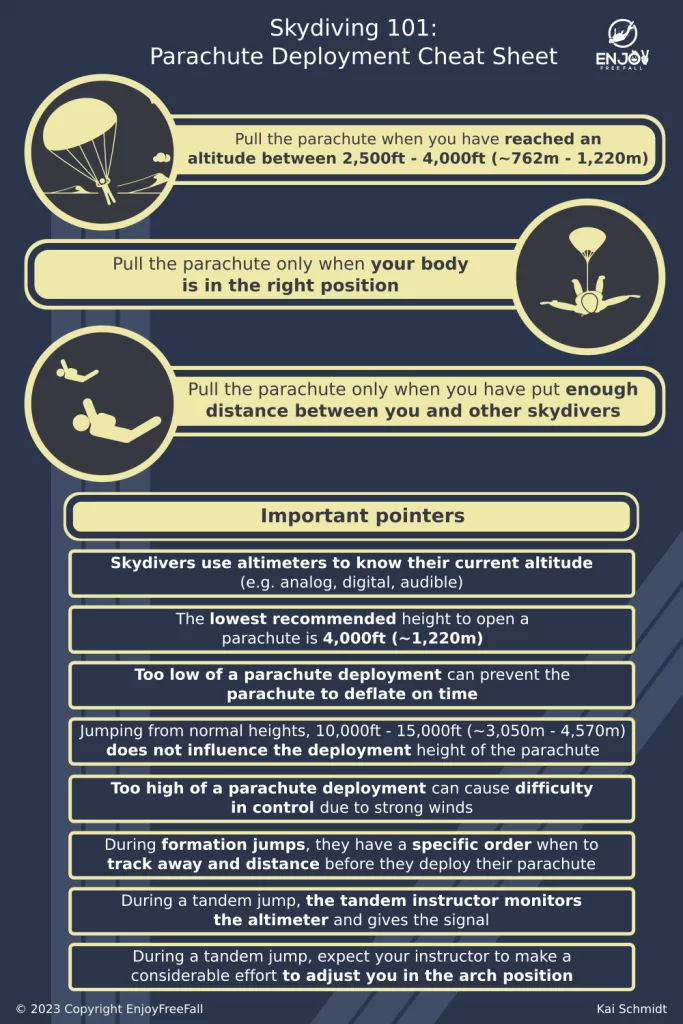
Once you leave the airplane, things will happen fast: You fall for about a minute at a high speed and you have to deploy the parachute to safely reach the ground. But the most important question is when do you have to deploy the parachute?
Here are the three conditions when to pull the parachute:
- When Reaching an Altitude Between 2,500 – 4,000 ft
- When Your Body Is in the Right Position
- When You Have Put Enough Distance Between Yourself and the Other Skydivers
Since skydiving is a self-regulated sport, both beginners and experienced skydivers are expected to follow those three deployment regulations set by the FAA and USPA. The safety rules help to avoid accidents that might result in injuries or even fatalities. By following these indicators, you will be able to smoothly deploy your parachute and safely reach the ground.
When Reaching an Altitude Between 2,500 – 4,000 ft
One of the challenges of skydiving is that people lose their feeling for distance and speed. Because the eyes do not have any fix points and everything looks small on the ground, it is difficult to say if someone is 2,000 or 6,000 ft above the ground.
In that way, skydiving is not as simple as walking in a park where you will easily know how much distance you have covered and where you can stop once getting tired.
Since skydiving is a sport that involves risks and skydivers need to be precise and accurate in every action to avoid accidents.
How Do Skydivers Know Their Current Altitude?
Skydivers use specialized equipment to help them track their current altitude. This equipment is called an Altimeter. The altimeter is usually attached to the skydiver’s wrist so that they can easily monitor their altitude and know when to pull their parachute.
There is a wide range of altimeters to choose from and you can find a quick overview of their advantages below:
Analog Altimeters have a bigger display and are color-coded. As a result, it is often easier to see the height. They are also less expensive compared to their digital counterparts. However, the downside is that they are less accurate, bulky, and big on the wrist.
Digital Altimeters are more accurate and have data storage wherein you can see the history of your freefall speed. Since they are electronic, they have batteries, and you need to constantly monitor the battery life. It is also a bit harder to read especially when the sun is too bright. They are also more expensive compared to analog altimeters.
Lastly, Audible Altimeters are placed in the ear pockets inside of the helmet. They will beep at the preset or pre-programmed altitude such that one does not constantly monitor the altitude. However, I recommend only using them as a backup device and as an extra layer of awareness. You will feel more uncertain if you cannot constantly monitor your altitude.
Before the jump, skydivers set a specific altitude at which they will pull their parachute. It is important to make up someone’s mind about when to pull the parachute beforehand. Skydivers can then preprogram the altimeters and know how much time they have to complete the maneuvers or formations that they want to do.
If you think about getting one, check out this guide to find the right altimeter.
Surprisingly, some experienced skydivers develop a good sense of heights over the years in the sport. They become so experienced that they can use their instincts to know when to pull the parachute. They become familiar with the dropzone and know when they are too close or too far from the ground.
Developing this skill, however, takes years and it is very dangerous to solely rely on it.
How Do You Know When to Deploy the Parachute During A Tandem Jump?
During a tandem jump, the tandem instructor monitors the altimeter and gives a signal (hand gesture or tap on the shoulder) to the student jumper before he pulls the parachute. It normally happens after about 40 – 60 seconds of freefall and at a height of 5,000ft.
In general, student jumpers do not need to worry about the deployment process since most of the work will be done by their trained instructor. However, the student’s cooperation is still important and makes the job of the tandem instructor easier. If the student follows the instructions and moves in the right body position it also will be a more comfortable deployment process and canopy ride.
While the opening height for tandem jumps is relatively fixed, the opening height for solo jumps depends on the skydiver’s level of experience. Some solo skydivers want to experience a longer freefall so they wait until they reach the recommended minimum altitude before deploying their parachutes.
If you are performing a tandem jump soon, make sure that you check out my skydiving 101: everything you need to know about your tandem landing. It explains in detail what you as a tandem student can do to ensure a safe landing!
What Is the Minimum Altitude to Open the Parachute During Skydiving?
Not only is the level of expertise important for the minimum opening altitude but also is the type of jump performed due to different equipment and falling speeds.
For tandem jump, the lowest recommended height to open a parachute is 4,000ft (1,220m). This will give the instructor enough time to resolve any malfunctions. Deploying at such an altitude also gives students more time to admire and be amazed by the breathtaking view below them.
The lowest recorded height for a tandem jump is at 1,200ft (366m) – something which should not be replicated.
For skydive solo jumps, the minimum recommended height varies between 2,500 – 4,000ft (762 – 1,220m) depending on the skill level of the skydiver. Beginners should open their parachutes at 4,000ft while more experienced jumpers often wait up to the last second to open their parachutes. They then have more time to practice more maneuvers and to enjoy a longer freefall.
The lowest recorded height for a solo jump is at 800 – 1,000ft (244 – 305m).
The opening height for base jumpers is around 450 ft. Base jumpers use specialized parachutes that open faster and below terminal velocity. Because their jumping height is very low, they often have to pull the parachute seconds after jumping.
If you want to get more details about this topic, feel free to read my article about the minimum altitude to open a parachute. It explains in detail how the altitude differs by jump type, what the current world records are and why it is unlikely that any of the records will be broken soon.
What Is the Maximum Recommended Height to Open a Parachute?
Theoretically, there is no maximum height at which skydivers can deploy their parachutes. Skydivers could deploy their parachute immediately after exiting the plane and then steer the canopy down.
In practice, however, deploying too high can be dangerous for skydivers if they are not prepared for it. As skydivers usually jump in groups, there is a specific order of who jumps and deploys his parachute first. If someone alters from this order, he puts himself and other skydivers at risk as they might collide.
If two skydivers collide, one can be hit unconscious, the canopies can break, or the lines can get entangled which often results in injuries or fatalities. Another problem that might occur when you jump in a busy area is that the skydiver might collide with another aircraft.
Another risk of deploying the parachute at a maximum height arises from strong winds. Wind speed normally increases quite strongly with increasing altitudes and therefore is much stronger in the sky than on the ground. Controlling the canopy in stronger winds is much more difficult for the skydiver and requires a higher skill level.
A strong wind can throw the skydiver around and result in parachute malfunctions, spiraling canopies, and line entanglements. It can also drift skydivers away from the dropzone such that they need to land in unknown territory. Landing in unknown territory is dangerous because one might hit any objects on the ground.
When a parachute is opened too early, the skydiver is also confronted with lower temperature and oxygen levels. Depending on the time of the year, there can be a huge temperature difference between 14,000ft (4,200m) and the usual deployment height of 2,500ft (750m). Lower oxygen levels will make skydivers tired faster. This can affect his ability to steer the canopy and to keep his orientation up (and this might result in human errors).
It will also be a mentally and physically exhausting ride since skydivers need to observe the environment for other aircraft and skydivers, navigate through the air without losing orientation and steer the canopy.
To learn more information about the three underestimated risks of early parachute deployment, you can also refer to this post.

Does the Parachute Deployment Height Depend on the Jumping Height When Skydiving?
If skydivers jump from normal jumping heights (between 10,000 – 15,000 ft) the jumping height does not influence the deployment height of the parachute. This is because skydivers reach a similar terminal velocity i.e. the same maximum falling speed when jumping from 10,000 or 15,000 ft.
The deployment heights are usually set to 2,500 – 4,000 ft because skydivers have enough time to resolve any kind of problem that might occur. It will also give the parachute enough time to inflate and decelerate the speed.
As skydivers have the same falling speed when jumping from 10,000 or 15,000 ft, they will also have the same amount of time to deal with any problem when pulling at the same height. Hence the deployment height does not alter.
However, if skydivers perform a so-called HALO jump (“high altitude low opening”) from extreme heights they will reach a faster terminal velocity. Since their speed is faster than for usual jumps, they should also deploy their parachute earlier.
The lowest recommended deployment height is also dependent on the skill level of the skydiver. Time plays a key role again. Someone who holds a D license and has performed more than 500 jumps is expected to resolve any problem faster than novice skydivers. As a result, they can open their parachutes at lower heights.
Only Open the Parachute if Your Body Is in the Right Position
The belly-to-earth position is the most stable and safest position when deploying a parachute. It serves as a foundation to develop other skydiving positions. Once a solo skydiver has mastered a great arch position, he can then practice other positions such as head-down flying, sit-flying, or stand-flying. At some point, he can even do flips and other more advanced maneuvers.
However, no matter how experienced a skydiver becomes, the belly-to-earth position is by far the safest and most comfortable position to pull the parachute. Even though experts could deploy their parachute at a different body position, most will always move their body to the belly-to-earth position because it is so much more comfortable and safer.
Not being in the right body position when opening the parachute exposes the skydiver to unnecessary risks. Specifically, if skydivers open their parachutes when they are not in a stable position but spin around uncontrolled, the lines of the parachute might get entangled and prevent the parachute from opening properly.
I’m sure you’ve noticed how cool experienced skydivers look when maneuvering through the air. Sure, it looks easy, but did you know that skydiving requires technique and precision to achieve the desired results? I wrote an article about it here where I go in detail on how skydivers use their bodies to control their speed and movements during freefall.
How to Put Your Body in the Right Position During a Tandem Skydive
During the tandem jump, you can expect your instructor to make a considerable effort to adjust you in the arch position. It’s like creating a “banana” shape with your body so that the air during the freefall will be moved smoothly and stabilizes your position.
To do this, the thighs should be higher than the pelvis, feet are flat and parallel to each other, toes are pointed while arms are stretched out and higher than your ears level.
When You Have Put Enough Distance Between Yourself and the Other Skydivers
Theoretically, it is safe to open a parachute a few seconds after exiting the airplane. However, it is better to wait for another second until you can see the entire aircraft before pulling the parachute. This is to avoid any possible collision accidents that might lead to injuries or fatalities.
When jumping in a group, you need to put enough space between you and other skydivers before deploying your parachute. Check if no one is above or near you. Once that is confirmed, you can safely deploy the parachute and you no longer need to worry that you might collide with someone else.
Putting enough distance between the skydivers is also the reason why group jumps have to follow a specific jumping order. A few seconds between each jump make a lot of difference in terms of distance since skydivers are traveling at a high speed.
Student jumpers who enrolled in AFF Full Course include tracking lessons that allow them to learn how to gain a safe distance from other skydivers before deploying the parachute.
When performing formation jumps or maneuvers, skydivers normally move away from each other at a particular height to give each skydiver enough time and space to open their parachutes.
The Role of Wind Speed and Direction When Skydiving
Knowing the wind speed and direction is important in determining the right altitude to open a parachute. As winds in the sky are stronger compared to the wind at the grounds, skydivers are recommended to check the wind aloft forecasts for multiple heights.
During strong winds, it is recommended to open the parachute a bit later because the winds will drift skydivers off the dropzone, and steering the canopy will be hard.
However, never open the parachute below 2,000 feet since it usually takes between 200-400ft for the parachute to open. As a result, the skydiver will not have enough time to deal with any malfunctions. The parachute will also not have enough braking time before landing – which will most likely have deadly consequences.
As your skydiving level progresses, you will be more familiar with reading the speed and direction of the wind. Aside from the wind aloft forecast, skydivers also use the windsocks at the dropzone to monitor the direction and speed of ground winds.
As the altitude goes down, the wind speed also decreases which will be much safer and ideal to deploy a parachute.
Are you curious about how likely you will get injured during a skydive? Check out my article about the true risks of skydiving. It will give you a mind-blowing, new perspective of the sport!
Do Skydivers Need a Certain Speed to Open Their Parachutes?
A typical skydiver in a belly-to-earth position will reach terminal velocity at a speed of approximately 120 mph (193 km/h) and will freefall for about 30-60 seconds before opening the parachute. Once a parachute is open it reduces the speed down to at least 90% and skydivers glide to the ground at a relatively low speed of 12 mph.
However, skydivers do not need to reach a minimum speed before the parachute inflates properly. When skydivers fall at a lower speed (for example because they deploy directly after exiting the aircraft), they will accelerate until the air resistance is strong enough to inflate the parachute. It, therefore, takes longer to inflate.
The terminal velocity varies on different factors such as jump height, jumper’s weight, position, and weather conditions. If you want to learn more about the distance and time to reach terminal velocity and how to achieve higher speeds, check this post.
When to Pull the Parachute During a Formation Skydive
Formation jumps are the supreme form of skydiving. In the air, multiple skydivers try to imitate a figure by grabbing each other and maneuvering themselves in the corresponding form.
Once the formation is complete, skydivers hold it for a few seconds until they break apart and track away from each other. Depending on how many people take part in the formation jump, they also have specific orders on who breaks apart first and maneuvers away. They also determine the direction in which each skydiver is supposed to fly before the jump.
Once they have reached a safe distance, skydivers can deploy their parachutes. Because tracking away is not that easy when many people are around them, skydivers need to be experienced before they will take part in formation jumps.
In general, with proper training, strong altitude awareness and the presence of mind skydivers will know when to pull the parachute.
That being said, enjoy your freefall!




